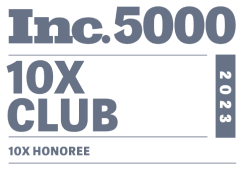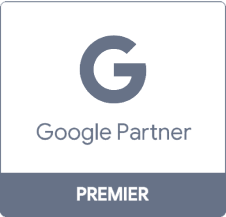- Home
- Digital Marketing
- Learn Customer Journey Case Studies
5 Unique Customer Journey Case Studies
This process is often referred to as the customer journey, and it’s unique to each one of your customers or clients. Some journeys are more common than others within certain industries, but it’s rare that any two customers follow the exact same path to conversion.
At WebFX, we see these journeys play out each day both with our own marketing strategy and with our clients’. Regardless of how we structure our campaigns, there is always variation in how individual users find and react to advertisements, social media posts, blog posts, and other online content.
Still, some marketers expect to have complete control over how their potential customers interact with their content and go through the process of converting.
That’s why we pulled together these five examples of real customer journeys from our clients. These clients work in industries ranging from ecommerce to heavy equipment to a local restaurant, and they’ve each seen interesting results.
All five use Internet marketing strategies to reach new customers, but they’ve all generated conversions in very different ways.
Call 888-601-5359 to speak with a strategist about how we can get results like this for your business, or keep reading for the case studies.
Good agencies have more than 50 testimonials.
Great agencies have more than 100 testimonials.
WebFX has over 1,100+ glowing client testimonials.
See What Makes Us Stand out

1. Assisted conversions: VF Outlet
An assisted conversion is when a channel guides someone down the sales funnel, but is not the final conversion interaction.
For example, a user could access a site through a display marketing campaign, leave, then come back through organic search and convert. So even though they ultimately converted from an organic session, the session from the display campaign assisted.
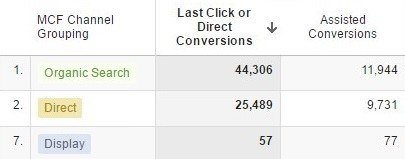
So in this example, Display actually assisted with more conversions than it generated. This means that if VF Outlet were to look at their results strictly in terms of the last touchpoint before a conversion, it would be reasonable to conclude that Display ads didn’t produce many leads – which isn’t the case.
Assisted conversions can take many forms. In some cases, the path to conversion is fairly straightforward and only involves one or two channels.
![]()
In this case, a user found the site via organic search, then navigated directly to the site and made a purchase.
In other cases, the path is more complex.

In this instance, for example, the lead made contact with five different aspects of VF’s marketing campaign before ultimately converting.
This just goes to show that unless you take assisted conversions into account, you shouldn’t discount a marketing channel just because it doesn’t directly generate leads.
2. Time lag: Cleveland Brothers CAT
Some users see what they want and buy right away, while others need to take their time and evaluate their options. This can lead to multiple sessions and weeks before seeing a conversion.
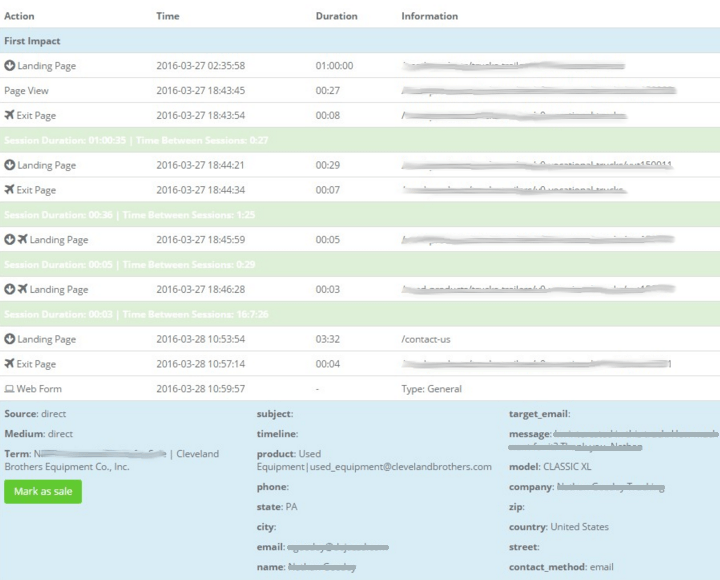
In this case, the lead only took one day to convert. Although they left and revisited Cleveland Brothers’ site multiple times within that time period, it was a fairly short customer journey.
That being said, conversions often take much longer.
When we look at the average time lag for each conversion on the same site, we can see that although most visitors submitted a lead form within a day of visiting, many of them took a month or longer.
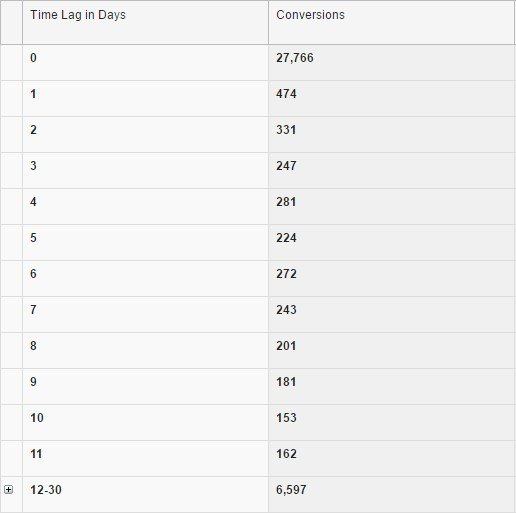
In the majority of these cases, however, those visitors didn’t simply remember their purchase intent weeks after visiting Cleveland Brothers’ site. So why did they come back and convert?
Because of an effective lead nurturing strategy.
This means that if you don’t stay in contact with your visitors after their first visit to your site, you could miss out on a huge opportunity to bring them back to convert. There are a variety of ways to do this.
If a user signs up for an email newsletter, you can create automated drip email campaigns that keep your company at the front of their minds – and their inboxes. And even if they don’t, you can use cookies to run retargeted display ads on other sites. You can read more about lead nurturing here.
When you make an effort to stay reach users even after they’ve left your site, you increase your chances that they’ll remember your business and eventually become a customer.
3. Mobile conversions: JuiceBlendDry
The ways we access and browse the Internet are very different from what they were just a few years ago. Users no longer limit themselves to one device, and many people access the Internet on smartphones just as much as they do their desktop computer.
And even within those devices, there are many different browsers users can choose. As you create your site and strategy, you need to take all of these platforms should be taken into account.
In the case of ecommerce retailer JuiceBlendDry, over one third of their sales take place on mobile devices, and 15% take place on tablets.
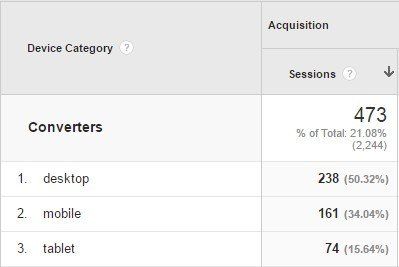
This means that if their site weren’t compatible with devices other than desktop computers, they’d miss out on over half of their sales.
It’s also worth mentioning that even for their desktop sales, their customers made purchases on several different browsers. Although Chrome is now by far the most popular desktop browser, less than half of their sales took place in it.

This means that if they’d exclusively run tests in Chrome, they would’ve lost more than half of their desktop visitors. That’s a huge loss of sales and overall revenue.
Although most businesses today are aware that their customers access their sites on multiple devices, these examples just underscore the importance of responsive design. If you ensure from the start that your site is compatible with all devices and browsers, you never have to worry about missing out on sales just because your site doesn’t load correctly for a potential customer.
4. On- and off-site conversions: Bricco
Not all customers convert the same ways. Depending on your industry and business model, your site visitors could become customers by making an ecommerce transaction, submitting a lead form, calling you for information, or other actions.
This is certainly the case with the restaurant Bricco.
If we look at their online leads submitted for this specific day, it appears only one person made a reservation after visiting their site.

But when we look at the calls recorded with call-tracking software, it’s clear that several other customers contacted the restaurant by tapping the phone number button on their site.

Granted, we can’t tell from this screenshot whether each of these callers ultimately made a reservation. But if call recording is enabled, they could easily listen to each call and determine the final result.
Alternatively, they could simply record reservations in a separate program and see which ones were a result of calls from their site.
Regardless, each of those calls represents a conversion, and one that wouldn’t have been attributed to Bricco’s Internet marketing strategy without call tracking software. If this were the case over a long period of time, they may have concluded that their SEO strategy wasn’t producing leads – even though it generated multiple calls per day for their business.
This means that if you aren’t already tracking both your online and offline conversions, it’s important that you start. The more information you have, the more accurately you can attribute your overall marketing strategy and improve it moving forward.
5. Site interaction: deRamon Plastic Surgery Institute
Your potential customers all arrive on your site with varying degrees of knowledge about your products and services. Some users know what they want immediately, while others have a lot to learn before they’re ready to make a purchase or contact you for a consultation or quote.
This means that if you want to convert visitors in the latter group, your site needs to provide all of the information they need. Otherwise, they’ll return to search results and look for a site that does – which is one of your competitors.
So how can you determine what kinds of information your customers want?
Unfortunately, there’s no cut and dry way that customers interact with a website. But when you look at the Users Flow feature in Google Analytics, you can see common paths your visitors take through your site.
In the case of deRamon Plastic Surgery, this feature shows that a significant percentage of their visitors visit their gallery page immediately after landing on the home page, and another large portion visits a page for a specific service.

Based on this information, they know that their customers’ primary interest is seeing examples of their past work.
This may not come as a surprise, but having the data to back it up gives them a reliable reason to make that page as informative as possible and update it with new photos and client testimonials on a regular basis.
From there, you can also see what your visitors do after visiting a specific page. This is especially useful for pages with a large number of drop-offs, as it allows you to identify areas of your site that receive lots of traffic but don’t convert customers.
If you’ve never checked out the Users Flow feature in Google Analytics, it’s worth your time. The more you know about how your visitors interact with your site, the more effectively you can optimize it to keep them here and convert them into customers.
We foster and form long-term partnerships so that your business has long-term results.
Over 90%
Want to learn more about your customers’ journeys?
As all five of the examples above demonstrate, you can learn a lot about your customers by spending some time in your site’s analytics. This information can help you improve your marketing strategy, reach more customers, and generate more revenue.
If you’d like to learn more about how your customers interact with your site, we’d love to help!
At WebFX, we have years of experience creating and managing Internet marketing strategies for our clients. We monitor and analyze the results of each of these campaigns on a regular basis, and use that information to continuously improve each one.
For more information about how we can create an effective strategy for your business, contact us today to speak with a strategist!
Related Resources
- 3 Simple Ways to Find the Questions Customers Need Answers to
- 4 Cost-Effective Ways to Do Market Research Online
- Benefits of Market Research Surveys
- Bottom of the Funnel Marketing: It’s Not Magic. It’s Marketing.
- How Marketing Works in the Customer Journey
- How the Buyer’s Journey Affects Your Content Marketing
- How to Create Emails for Every Stage of the Buyer’s Journey [Examples]
- How to Develop an Effective Sales Funnel
- Improving UX: User Journey & Customer Journey Mapping
- The Modern Digital Marketing Funnel
Marketing Tips for Niche Industries
- CRM for Electricians
- CRM for Industrial Companies
- CRM for Insurance Agents
- CRM for Recruiting
- Dealer and Distributor Marketing Services
- Dealer Inventory Feeds: Dealer Inventory Management from WebFX
- DealerFX: All-In-One Channel Marketing Solution
- Dermatology Digital Marketing Strategies
- Dig into These 50 Restaurant Industry Statistics
- Digital Marketing for Agriculture: 5 Ways to Boost Sales





